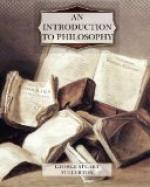Nevertheless, men often speak of thousandths of an inch, or of millionths of an inch, or of distances even shorter. Have such fractions of the magnitudes that we do know and can perceive any real existence? The touch world of real things as it is revealed in our experience does not appear to be divisible into such; it does not appear to be divisible even so far, and much less does it appear to be infinitely divisible.
But have we not seen that the touch world given in our experience must be taken by the thoughtful man as itself the sign or appearance of a reality more ultimate? The speck which appears to the naked eye to have no parts is seen under the microscope to have parts; that is to say, an experience apparently not extended has become the sign of something that is seen to have part out of part. We have as yet invented no instrument that will make directly perceptible to the finger tip an atom of hydrogen or of oxygen, but the man of science conceives of these little things as though they could be perceived. They and the space in which they move—the system of actual and possible relations between them—seem to be related to the world revealed in touch very much as the space revealed in the field of the microscope is related to the space of the speck looked at with the naked eye.
Thus, when the thoughtful man speaks of real space, he cannot mean by the word only the actual and possible relations of arrangement among the things and the parts of things directly revealed to his sense of touch. He may speak of real things too small to be thus perceived, and of their motion as through spaces too small to be perceptible at all. What limit shall he set to the possible subdivision of real things? Unless he can find an ultimate reality which cannot in its turn become the appearance or sign of a further reality, it seems absurd to speak of a limit at all.
We may, then, say that real space is infinitely divisible. By this statement we should mean that certain experiences may be represented by others, and that we may carry on our division in the case of the latter, when a further subdivision of the former seems out of the question. But it should not mean that any single experience furnished us by any sense, or anything that we can represent in the imagination, is composed of an infinite number of parts.
When we realize this, do we not free ourselves from the difficulties which seemed to make the motion of a point over a line an impossible absurdity? The line as revealed in a single experience either of sight or of touch is not composed of an infinite number of parts. It is composed of points seen or touched—least experiences of sight or touch, minima sensibilia. These are next to each other, and the point, in moving, takes them one by one.
But such a single experience is not what we call a line. It is but one experience of a line. Though the experience is not infinitely divisible, the line may be. This only means that the visual or tactual point of the single experience may stand for, may represent, what is not a mere point but has parts, and is, hence, divisible. Who can set a limit to such possible substitutions? in other words, who can set a limit to the divisibility of a real line?




